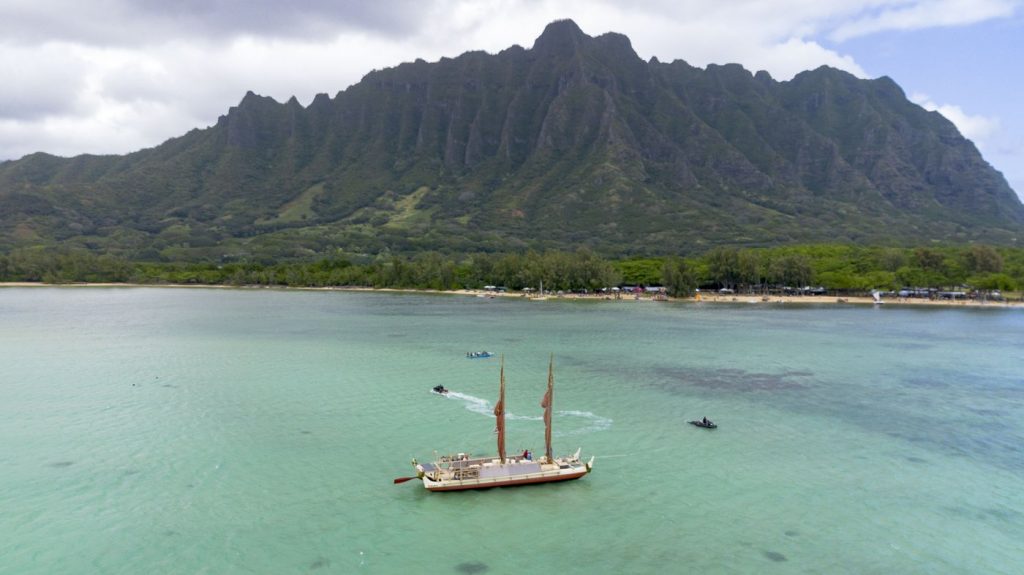KANEOHE, Hawaii (AP) — Hawaii's American colonizers historically suppressed the Hawaiian language in schools, leading to a loss of cultural identity among Native Hawaiians. Instances of skin-lightening attempts with lye reflect the extent of this cultural shame. Contrasting this history, the launch of the double-hulled sailing canoe Hokulea in 1975 marked a pivotal moment in the revival of Hawaiian culture, emphasizing the mastery of traditional navigation by reading the stars, waves, and weather.
To commemorate this significant anniversary, early crew members of Hokulea gathered for a ceremonial hula and kava drinking at the launching site on Oahu beach. Nainoa Thompson, CEO of the Polynesian Voyaging Society, described the canoe as a "vehicle of exploration" and a "vehicle of discovery," embodying justice for Native Hawaiians and Pacific Islanders.
Thompson made history in 1980 as the first Hawaiian in six centuries to navigate from Hawaii to Tahiti without modern instruments, covering approximately 2,700 miles (4,300 kilometers). This journey symbolized the reclamation of Hawaiian culture that had been suppressed for generations.
Growing up with stories from his grandmother, who faced punishment for speaking Hawaiian, Thompson highlighted a disconnection from heritage. Instead of teaching her children their language, she chose to shield them from societal harm, reflecting the broader repression of Hawaiian culture. However, a cultural renaissance, ignited in the late 1960s and 1970s, began to reshape perceptions of Hawaiian identity. Artists like Herb Kane embarked on reviving ancient canoes based on historical drawings, leading to the inspiration for Hokulea's construction.
Many doubted the navigational prowess of Polynesians, believing they stumbled upon the islands by accident. The drifting log theory, popularized by Norwegian explorer Thor Heyerdahl, asserted that Polynesians arrived from South America. However, Hawaiian oral histories told stories of intentional voyages and skilled navigation. In a bid to debunk the drifting log narrative, Kane, University of Hawaii archaeologist Ben Finney, and surfer Tommy Holmes founded the Polynesian Voyaging Society, setting out to sail to Tahiti using traditional navigation methods.
They enlisted the help of Pius "Mau" Piailug, a Micronesian navigator skilled in traditional wayfinding. In 1976, under Piailug’s guidance, Hokulea successfully sailed from Hawaii to Tahiti, greeted by a crowd of 17,000 on the shore. This monumental event encouraged Hawaiian state delegates to embrace cultural revival, leading to the Hawaiian language being officially recognized and the establishment of the Office of Hawaiian Affairs.
Tragedy struck in 1978 when an unprepared crew set out for Tahiti, resulting in the capsizing of Hokulea. Eddie Aikau, a crew member, paddled for help but was never found. The Polynesian Voyaging Society revamped its training practices and goals in response. Thompson immersed himself in navigation studies under Piailug, eventually navigating to Tahiti successfully in 1980 and fulfilling Aikau’s legacy.
Over the years, Hokulea undertook voyages across the Pacific and beyond, inspiring other Pacific islands to recognize and revive their own navigation traditions. Hawaiian pride flourished as programs emerged to teach ancient voyaging skills in regions like Rapa Nui, Chile, and the University of Guam.
The influence of Hokulea reached the mainstream in 2016 with the release of Disney's "Moana," which depicted traditional navigation practices. Thompson influenced the film by sharing traditional wayfinding techniques, ensuring that cultural elements were accurately represented. Initially conceived as a single voyage for a documentary, the Hokulea has transformed into a powerful symbol of Hawaiian cultural pride and resilience since its launch in 1975.










